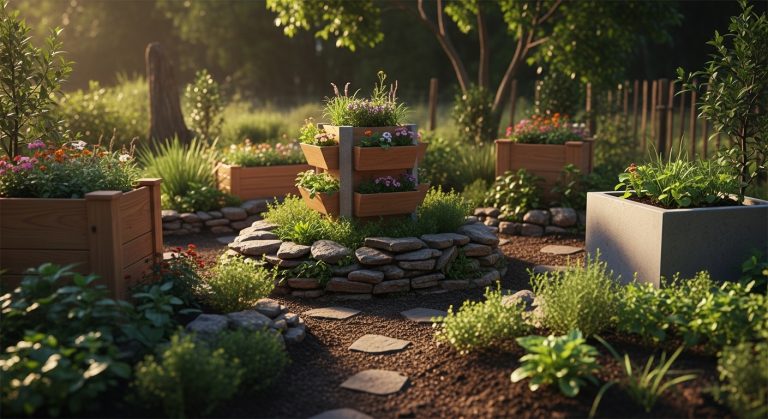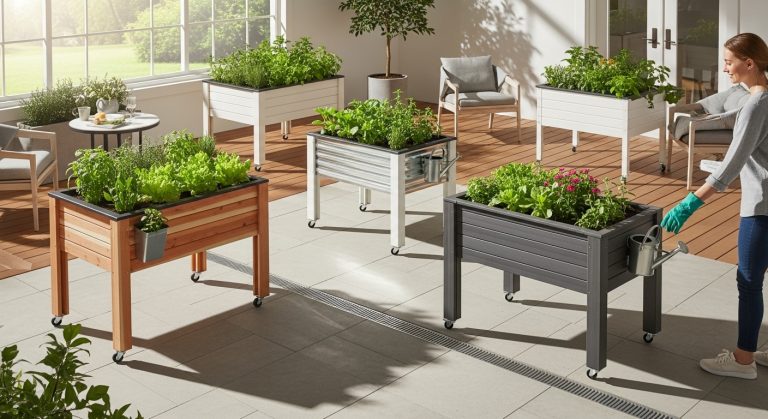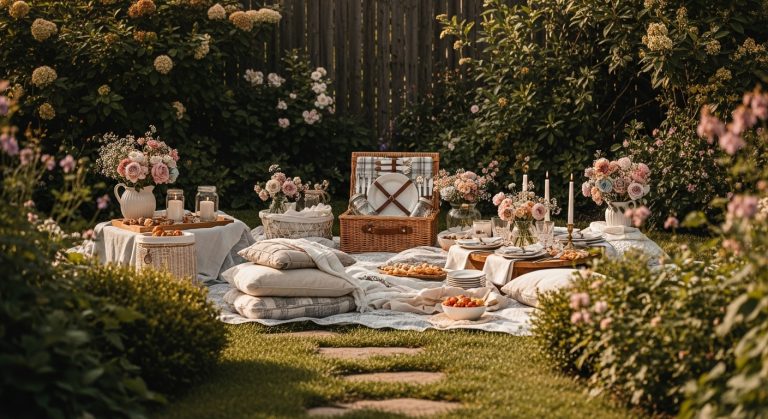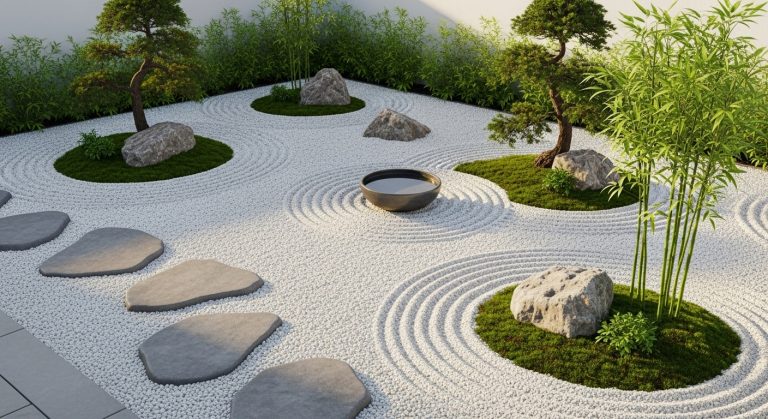Garden Bench Ideas: 15 Elegant Designs That Transform Outdoor Spaces
A garden bench isn’t just a place to sit — it’s a statement of style, a sculptural pause in nature’s rhythm. Whether nestled beneath a magnolia, floating along a gravel path, or perched against a stone wall, the right bench defines how we experience a garden. It’s where design meets serenity — where beauty and comfort coexist.
In today’s design language, benches have transcended utility. They’re focal points that whisper of romance, craftsmanship, and the luxury of stillness. From hand-carved teak to minimalist concrete slabs, each material and silhouette evokes a distinct mood — rustic, modern, coastal, or classic.
Here are 15 elegant garden bench ideas to elevate your outdoor space — whether you dream of a quiet retreat, an architectural feature, or a gathering place that feels like an extension of your home.
1. Sculptural Stone Benches — The Art of Permanence

There’s a timeless gravity to a stone bench. Carved from granite, limestone, or marble, it feels like part of the earth itself — weathered yet eternal.
Pros:
- Withstands all seasons — no maintenance needed.
- Adds architectural weight and visual balance.
- Pairs beautifully with classical or minimalist gardens.
Cons:
- Heavy and immovable once placed.
- Can feel cold without nearby greenery or soft textures.
A stone bench grounds a space — literally and visually. IMO, every sophisticated garden deserves at least one moment of stillness in stone.
2. Teak Wood Benches — Warm, Weatherproof Luxury
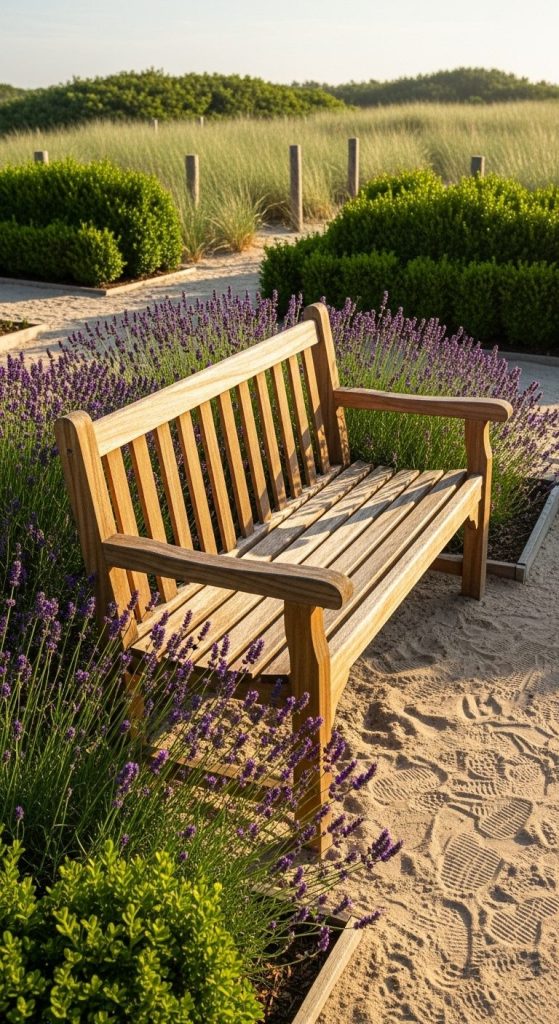
Teak is the gold standard of outdoor furniture for a reason. Its rich honey tones and natural oils make it as durable as it is elegant.
Pros:
- Naturally resistant to rot, mold, and insects.
- Ages gracefully to a silvery patina.
- Works across styles — from modern patios to English gardens.
Cons:
- High cost due to premium material.
- Occasional oiling helps maintain color.
There’s something undeniably chic about a weathered teak bench surrounded by lavender or boxwood. It feels coastal, calm, and timeless.
3. Wrought Iron Benches — Classic English Romance
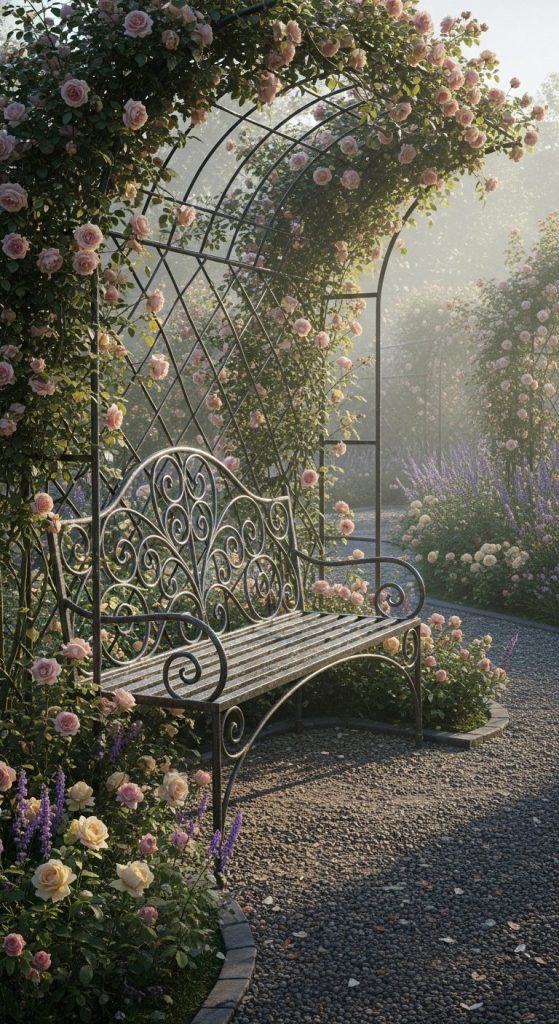
Wrought iron benches bring an old-world charm that feels straight out of a Victorian novel. Their intricate scrollwork catches the morning dew like lace.
Pros:
- Durable and ornate — perfect for vintage-inspired gardens.
- Paintable in custom finishes (black, white, pastel, or bronze).
- Creates a stunning focal point beneath rose-covered arbors.
Cons:
- Requires occasional rust protection.
- Heavy, not ideal for frequent repositioning.
A wrought iron bench turns a quiet garden corner into a poetic tableau — ideal for tea, reflection, or storytelling.
4. Concrete Minimalist Benches — Modern and Monolithic
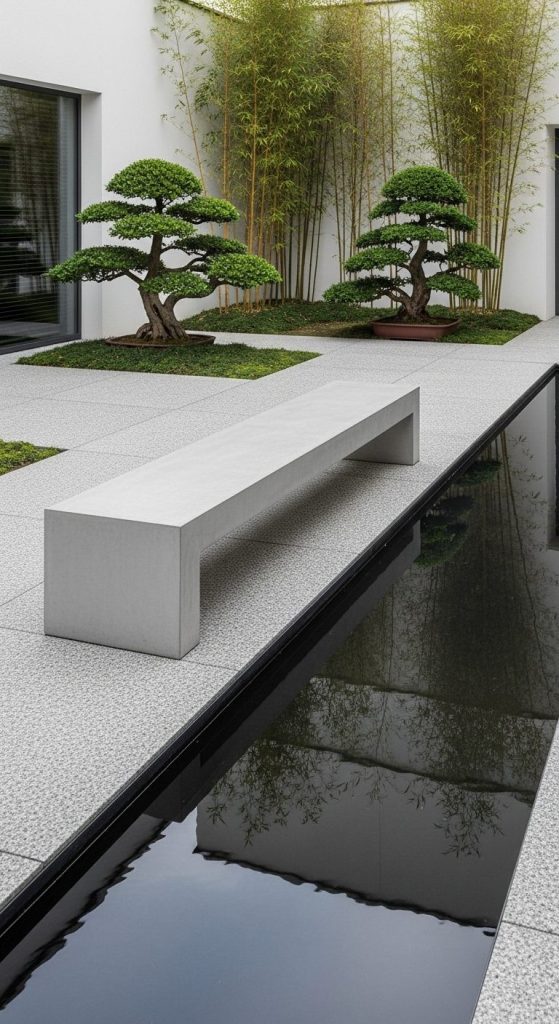
If you love clean lines and contemporary elegance, concrete benches are your match. Sleek and sculptural, they act as design punctuation marks in modern landscapes.
Pros:
- Ultra-durable and weatherproof.
- Complements minimalist, industrial, or desert gardens.
- Can be cast in custom shapes or finishes.
Cons:
- Cold to the touch — consider adding cushions.
- Needs thoughtful placement to avoid feeling stark.
Concrete benches are about restraint and confidence — proof that simplicity can be the ultimate sophistication.
5. Curved Wooden Benches — Flow and Function

Curved benches follow the natural rhythm of a garden, hugging pathways or encircling trees. Their organic form softens rigid layouts.
Pros:
- Encourages social seating — ideal for gatherings.
- Adds dynamic lines and fluidity.
- Works beautifully in naturalistic or Japanese gardens.
Cons:
- Custom designs can be pricey.
- Needs protection from moisture over time.
Few things feel as inviting as a curved teak bench under a sprawling oak — it’s like the garden itself is embracing you.
6. Reclaimed Timber Benches — Rustic, Sustainable Charm

There’s character in imperfection. Reclaimed timber benches tell stories — of barns, boats, and beams reborn into outdoor art.
Pros:
- Eco-friendly and full of texture.
- Perfect for farmhouse or bohemian gardens.
- Each piece is one-of-a-kind.
Cons:
- May require sealing for longevity.
- Irregular surfaces aren’t always “polished.”
In a world of mass production, reclaimed wood feels soulful. It’s design with memory — and a nod to sustainability.
7. Built-In Stone Wall Benches — Seamless Integration
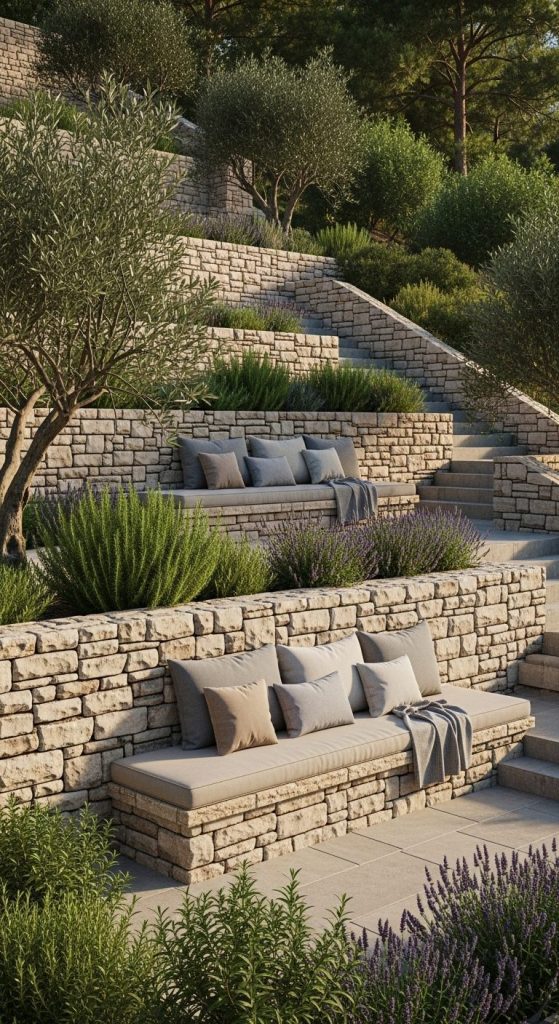
Why add furniture when your garden structure can serve double duty? Built-in stone benches blend into retaining walls, patios, and terraces.
Pros:
- Saves space and enhances cohesion.
- Incredibly sturdy and weatherproof.
- Offers an architectural, finished look.
Cons:
- Fixed — not suitable for rearranging layouts.
- Can be hard without cushions.
Built-ins whisper quiet luxury. They look effortless yet deliberate — a mark of thoughtful garden design.
8. Rattan or Wicker Benches — Breezy, Coastal Ease

Rattan brings indoor comfort to the outdoors. Its woven texture captures that relaxed, coastal chic energy.
Pros:
- Lightweight and comfortable.
- Adds texture and warmth to patios or verandas.
- Works well with linen cushions and tropical plants.
Cons:
- Not ideal for harsh weather; best under partial cover.
- May need reweaving after years of use.
A wicker bench beneath palm fronds and soft drapes evokes eternal summer — the kind of effortless luxury that never tries too hard.
9. Metal and Wood Combination Benches — Industrial Edge
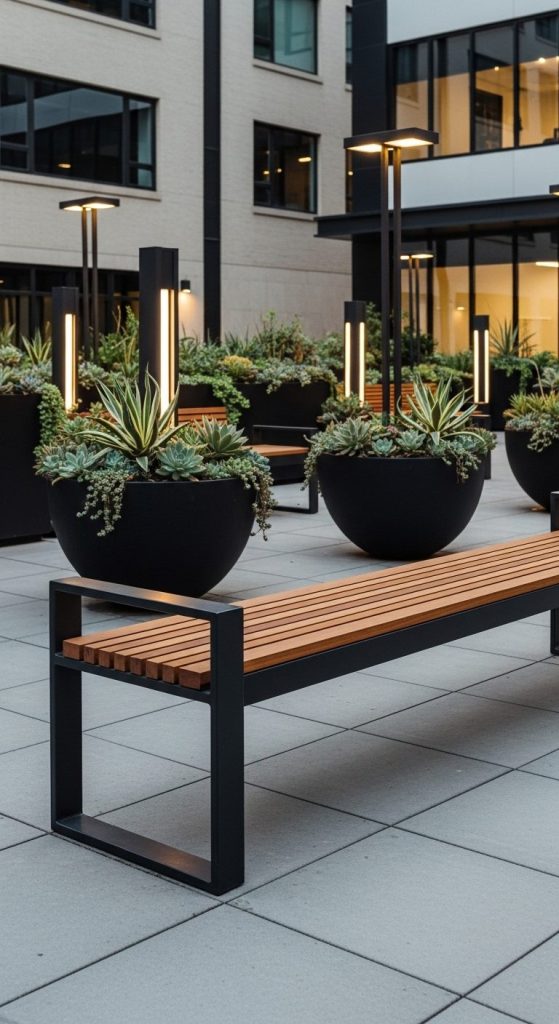
Mixing materials creates visual tension — metal frames with wooden slats are modern, versatile, and striking.
Pros:
- Sleek contrast between warm wood and cool steel.
- Works in urban or contemporary garden designs.
- Low maintenance and long-lasting.
Cons:
- Can heat up in full sun.
- Lacks the softness of all-wood benches.
For a courtyard or rooftop garden, this look hits that “designer-industrial” sweet spot — smart, urban, and functional.
10. Painted Garden Benches — Playful Pops of Color
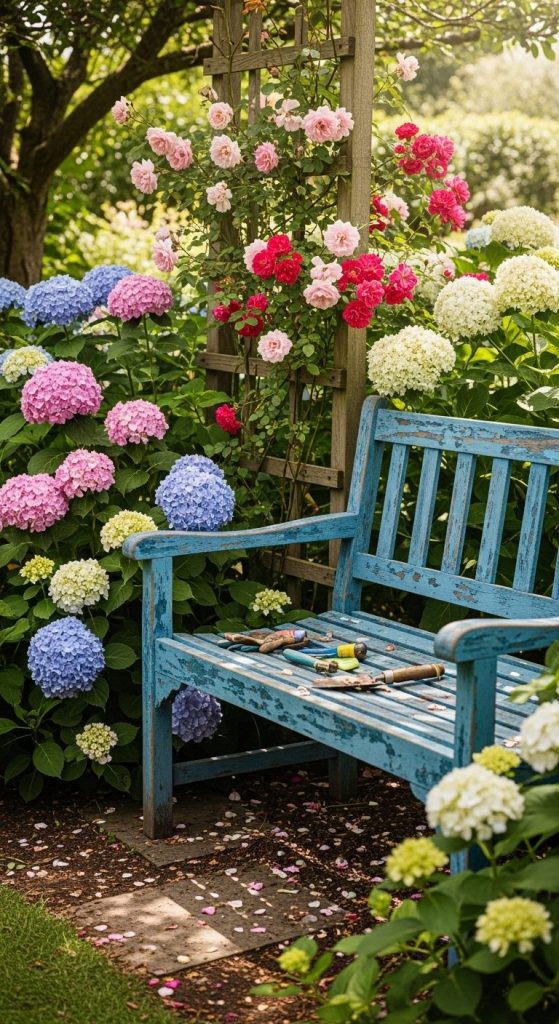
Who says benches must blend in? A bold color — emerald green, French blue, or coral red — can turn a quiet garden into an expressive canvas.
Pros:
- Instantly brightens neutral or green-heavy gardens.
- Allows personalization and seasonal refreshes.
- Works with both classic and eclectic décor.
Cons:
- Paint fades; touch-ups may be needed annually.
- Bold colors can dominate small spaces.
Painted benches are for those who see gardens as extensions of their personality — confident, joyful, and alive.
11. Floating Benches — The Illusion of Lightness
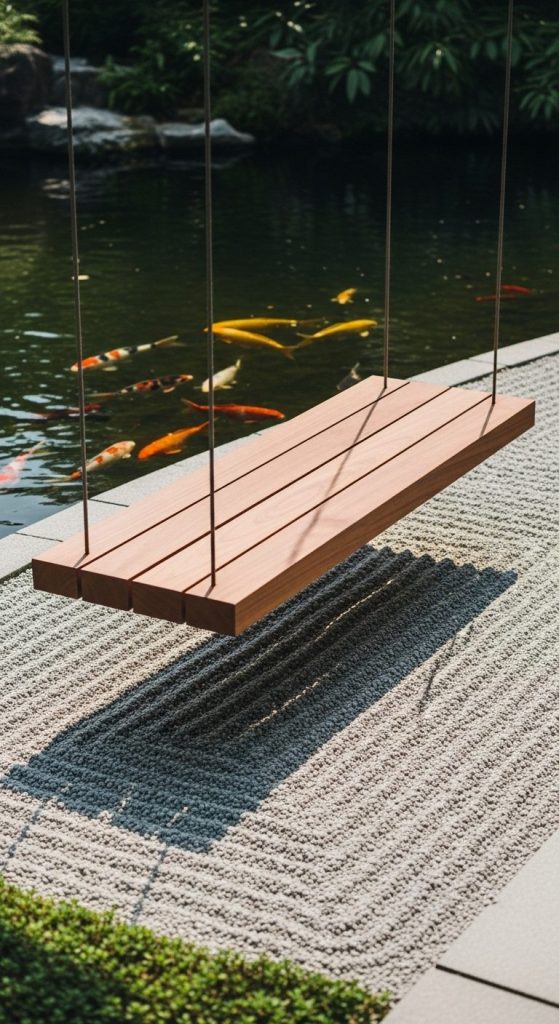
A floating bench, anchored subtly to walls or hidden bases, creates visual magic. It appears weightless amid foliage.
Pros:
- Clean, modern aesthetic.
- Saves visual space in tight areas.
- Perfect near water features or zen gardens.
Cons:
- Requires skilled installation.
- Limited weight capacity compared to solid bases.
Floating benches blur boundaries between art and engineering — minimal yet mesmerizing.
12. Tree-Bench Combos — Nature as the Nucleus
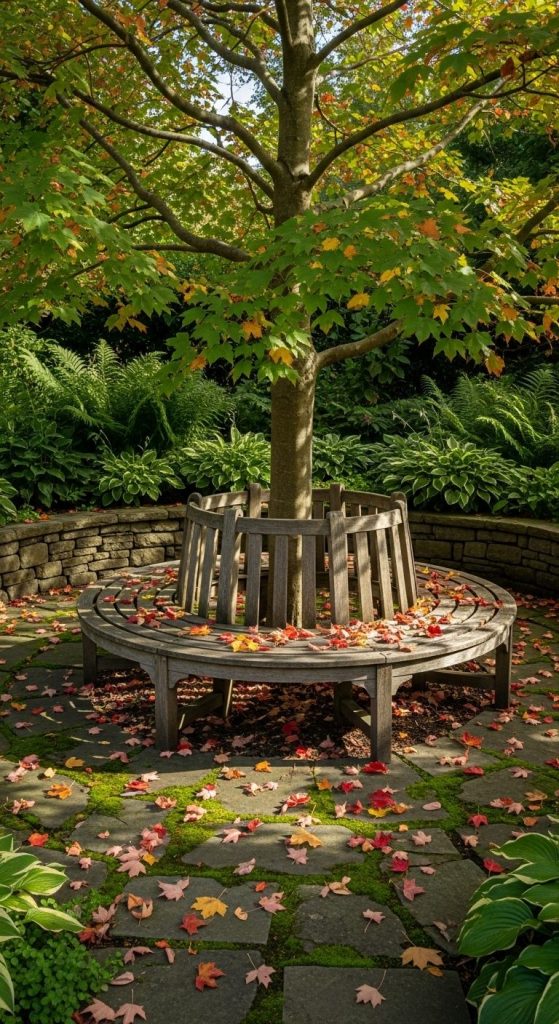
Benches that wrap around a tree celebrate nature as the centerpiece. They encourage shade, intimacy, and connection.
Pros:
- Utilizes space beautifully under canopies.
- Natural shade makes for cool, inviting seating.
- Creates a “destination spot” within larger gardens.
Cons:
- Needs flexible, segmented construction.
- Tree growth may require future adjustments.
It’s poetic, really — sitting beneath the very tree that shelters you. A full-circle moment in design and emotion.
13. L-Shaped Corner Benches — Social and Structured
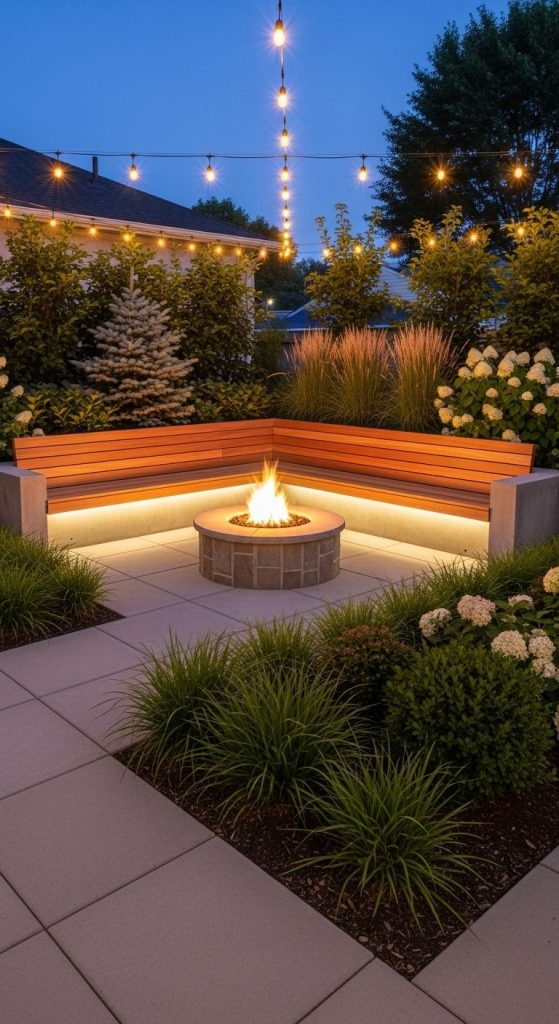
For patios or courtyards, L-shaped benches anchor gatherings. They create a sense of enclosure and invite conversation.
Pros:
- Maximizes seating in limited spaces.
- Perfect for fire pits or outdoor dining areas.
- Clean, architectural geometry.
Cons:
- Needs cushions for comfort.
- Permanent feel limits reconfiguration.
L-shaped benches bring indoor-style hosting outdoors — form meets function with sociable flair.
14. Mosaic-Tiled Benches — Mediterranean Splendor
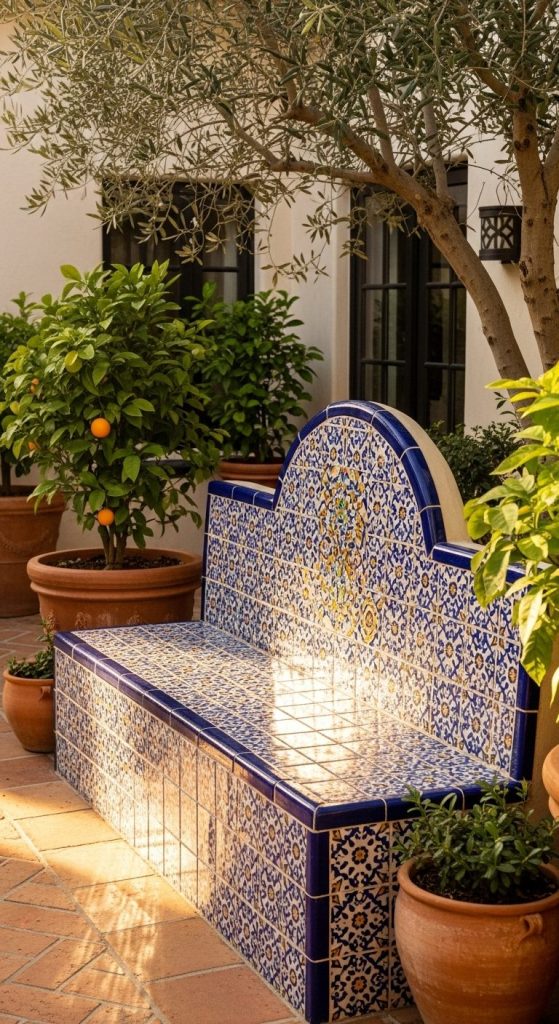
Tiled benches celebrate craftsmanship and color. From Moroccan zellige to Italian terrazzo, they’re a feast for the eyes.
Pros:
- Adds vibrant personality and artistry.
- Water-resistant and easy to clean.
- Great for Mediterranean or tropical garden themes.
Cons:
- Cold surface; not ideal for long lounging.
- Installation can be intricate and costly.
When sunlight dances across hand-laid tiles, the garden feels instantly more luxurious — like a villa in Seville.
15. Bench-and-Planter Hybrids — Greenery Meets Geometry

Modern designers love integration — and planter benches epitomize this. Built with inset planters or side compartments, they fuse seating with nature.
Pros:
- Compact and multifunctional.
- Keeps greenery close — perfect for herbs or succulents.
- Sleek, contemporary aesthetic.
Cons:
- Watering must be managed carefully.
- Custom fabrication costs more.
It’s design that breathes — merging comfort and cultivation into one elegant form.
Conclusion
Garden benches remind us that beauty isn’t just in what grows — it’s also in where we pause. From minimalist concrete forms to ornate wrought iron curves, the best designs reflect your home’s architecture and your personal rhythm.
A well-placed bench becomes a chapter in your garden’s story — a place where sunlight lingers, conversations unfold, and time gently slows. So, whether you favor stone permanence or wicker whimsy, choose a bench that invites you to stay a little longer. After all, great gardens aren’t just admired — they’re lived in.

William Martin is a passionate bowler who spends most of his weekends playing the sport. With years of intense experience under his belt, William decided to share his knowledge by creating BOWLING OCEAN. Join me on this journey to explore the world of bowling and discover the tips and tricks to becoming a pro.


